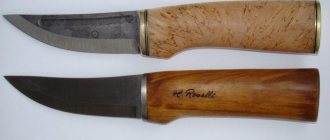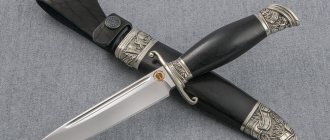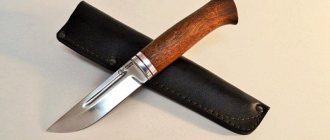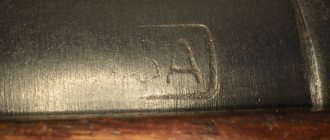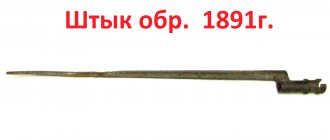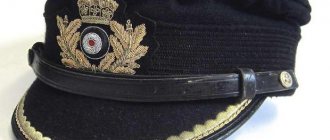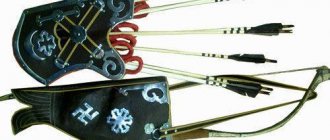The State Duma proposed fining citizens for illegally carrying bladed weapons. And although in Russia, unlike the Caucasian republics, there has never been a culture of carrying knives and daggers, some examples of edged weapons are still loved by Russians to this day. The first number on this list, of course, is the Finnka - a legendary knife glorified in literary works and criminal folklore. Minimal design changes allow you to transform it from a weapon into a utility knife with virtually no loss of combat qualities. It is not surprising that the advantages of the Finnish knife were appreciated not only by criminal elements, but also by law enforcement agencies, or more precisely, by the NKVD officers, to whom Finnish knives were issued as clothing allowance along with other ammunition. The history of the famous knife, which gained equal popularity among both bandits and law enforcement officers, was recalled by Lenta.ru.
And if you come across a lie in life, take out a red-hot Finnish knife
VIA "Tavern Smoke", composition "Finnish Knife"
Finka is a traditional Finnish knife with a straight blade and a wooden or bone handle without a guard (a stop-limiter between the blade and the handle). But if you type “finka” in a search engine today, then contextual advertising will for a long time offer the “legendary NKVD finca,” which only vaguely resembles the Finnish classic. Nevertheless, all modern Finnish women, including Russians, have a kinship with a distant Finnish ancestor. And this is not without reason: the Finns at one time came up with a surprisingly convenient, practical and multifunctional knife.
Today in Russia you can find both finks related to edged weapons and their analogues with the status of a household item. If the thickness of the butt (the upper, unsharpened part of the blade from the tip to the handle) of a finka is more than 2.4 millimeters, and the manufacturer, contrary to tradition, installed a guard, such a knife can be classified as a bladed weapon.
In this case, for purchase you need a hunting license, in which the Finn is entered along with firearms
State Duma deputies propose issuing administrative fines for the illegal wearing of such Finnish shoes. If the Finn does not have a guard, then the owner will not face any sanctions, even if the blade is thicker than the required 2.4 millimeters.
Traditional Finnish weapons in Russia were removed from the category of edged weapons back in 1996; today they are available to absolutely everyone - the seller will not even ask the buyer for a passport. But this was not always the case: Finnish women had a bad reputation in the USSR, and their trade was prohibited. But first things first.
And in the blue evening darkness you often see the same thing: It’s as if someone in a tavern fight stuck a Finnish knife under my heart.
Sergei Yesenin, “Letter to Mother”
Knife Era
Today, the Finnish knife is sometimes called the Russian Finnish knife. But what was he like before the prefix “Russian”? The Grand Duchy of Finland was part of the Russian Empire in 1809-1917. Both Russia and Sweden gradually tried to disarm the indigenous population of Finland - without weapons it is difficult to fight for independence.
Tactics that have been proven, if not for millennia, then for centuries. But the Finns as a people at the same time have a rich experience of stabbings. Puukkoyunkari have been operating in the country for too long.
Puukkoyunkari - Finnish stabbing bandits
Image: work by Santeri Alkio Puukkojunkkarit
As Denis Cherevichnik writes in his book “The World History of Stabbings,” two hundred years ago in one of the districts of the country - Southern Ostrobothnia - the number of murders suddenly began to increase at a dizzying speed. This era became famous in Finnish history as Puukkojunkkarikausi (pronounced puukkoyunkari) - the era of knifemen.
The era of knifemen lasted more than a hundred years, from the end of the 18th to the end of the 19th centuries. During this time, more than two thousand residents of Ostrobothnia died from the knives of their fellow countrymen. This is a lot, considering that at that historical period the population of the region was only eighty thousand people
Denis Cherevichnik, “World History of Knifes”
Some researchers compare this period with the American Wild West era. The calling card of a hooligan, a stabber, and perhaps part-time a freedom fighter, was also a Finnish knife. Of course, it’s unlikely that anyone other than our compatriots calls them Finns; the Finns themselves certainly don’t. Their knives are called “puukko”, since “puu” in Finnish means “forest”, “tree”.
Design Features
For any bladed weapon, the main characteristic is the effectiveness of practical use. The finka is precisely the kind of weapon that can be both effective in combat and useful in everyday life. The blade of the traditional Finnish version is short and pointed on one side. However, this blade length makes it easy to use the knife for cutting branches and sharpening stakes. The product is very convenient as a kitchen utensil and can be used for cutting game. The blade is equipped with a thick spine, which allows you to apply additional physical force. The block or handle of the finka can withstand a blow from a log or a hammer to the butt.
For the manufacture of knives, weapon steel with a hardness of 58 units on the Rockwell scale is usually used. A Finnish hunting knife, made using traditional ancient technology by Finnish blacksmiths, is made from a worn-out scythe. The metal in this case is soft and ductile, amenable to cold forging. The manufacturing technology of traditional Puukko-Finnish knives was as follows:
- worn-out braids are collected in a bag (2-3 pcs.);
- when heated, the package is forged until monolithic bars are obtained;
- the finished bars are riveted into narrow thin metal strips;
- then pieces of steel are cut to fit the size of the blade;
- the strip is forged and turned to the shape of the blade and shank;
- the handle is mounted on the blade.
Today, for the manufacture of various versions of Finnish knives, high-carbon steel is mainly used, where nickel and chromium are present as alloying additives. Nickel increases the metal's resistance to corrosion, and chromium makes the material more resistant. In ancient recipes for making Finnish knives, they tried to use durable steel. Today, the edged weapons market is dominated by cheap grades of steel, which are used for the mass production of knives of dubious quality.
High-quality steel allows the blade to maintain its sharpness for a long time. Proper and competent care of the blade will prevent rust from occurring.
Code in the knife
But if every first Finn had a simple working knife, then how to distinguish your own, how to identify a fighter for independence or just a hooligan stabber, a supporter of criminal sentiments? One of the opinions is that simple working knives had a regular wooden handle. And those for whom the knife was not only a working tool chose one with a beautiful handle.
Finn with a stacked handle
Photo: allzip.org
A stacked handle is when it is made from more than one piece of wood into which the shank of the blade is set (usually the shank is equal in length to the handle, this is a trivial issue of safety margin: you don’t need to chop wood with a good knife, but it must be strong).
For special versions of the knife, when you need to stand out, several wooden, bone or even leather washers of different colors were placed on the shank
I had to bother with the leather, because even if you take particularly thick leather, say, four millimeters, then for a handle of 12 centimeters you need 30 layers, and in fact even more, since the material shrinks during installation.
Photo: Alexander Ryumin / TASS
A handle made of wooden washers seems to be simpler in this regard, but it only seems so: there was no superglue, there were no metal repair shops and hardware stores in the basements of every large house. The fitting of parts was done by hand; cracks and crevices in such a handle spoiled the appearance - the handle would look much worse than the most ordinary “working” handle made from a single piece of wood.
Another cliche follows from this: “fighters for freedom and independence” were often not from the poor, most often they were the children of wealthy farmers or the farmers themselves.
Even in the Grand Duchy of Finland, the indigenous population treated these people differently: some considered them freedom fighters, others considered them highway bandits, robbers. Be that as it may, it is a historical fact: the villages in the Pohjanmaa region were under the control of hooligans, who always had a knife with them, and they used it very boldly.
Characteristics
Characteristics of a 1940 model army knife:
- total length of knife, mm 263
- blade length, mm 152
- maximum blade width, mm 22
- maximum thickness of the butt, mm 2.6
- Blade material Steel U7
- Handle material: wood
The blade has a beveled spine (“pike”, clip-point), the slopes occupy about half the width of the blade, and there is a pronounced heel in front of the guard for moving the index finger onto the blade. The most characteristic feature of the scout knife is the S-shaped crosshair of the guard, which has an unconventional bend: on the side of the blade, the guard stop is bent not towards the handle, but vice versa towards the blade. This unusual “inverted” guard is due solely to the combat orientation of the knife: the main grips were considered to be straight inverted with the blade directed upward (for bottom-up strikes to the abdomen and hypochondrium), or reverse (for top-down strikes to the neck area). In both grips, the knife lies in the hand “upside down” relative to the usual traditional position of the knife, therefore the guard received a corresponding bend. The handle and scabbard were made of wood and painted black (to avoid unmasking during night operations), but the blade was not blued or coated. It was recommended to carry the knife on the waist belt on the left side at an angle of 30°, with the handle to the right.
Weapons of the marginalized
If we talk about the Russian part of the Finnish history, then many criminals, robbers and hooligans in the north-west of Russia began to use classic Finnish knives even before the revolution. Often unchanged - a simple handle, the blade is much narrower
and also simple, with a slight bevel at the tip.
Some historians attribute this to the fact that since the 80s of the 19th century, the tsarist government began to Russify part of the Finnish territories in an attempt, among other things, to weaken the Finnish national movement. In a short period of time, “cultural exchange” led to the fact that the Finnish weapon became the most popular weapon of the marginalized people of St. Petersburg.
Then this fashion reached Moscow and other regions. And after the revolution, the level of crime jumped sharply - and something had to be done about it. In 1917, the Council of People's Commissars (SNK) came to power, which a year later issued a decree “On the surrender of weapons.”
Oblige the entire population and all institutions of the civil department to hand over the serviceable and faulty rifles, machine guns and revolvers of all systems, cartridges for them and sabers of all types. All weapons storage permits issued so far are considered invalid.
from Decree of the Council of People's Commissars No. 993 of December 10, 1918
Historians and researchers often agree that the Finnish woman, which by this time was already popular, after the decree of the Council of People's Commissars became an attribute of disobedience. Hooligans, punks, outcasts and other criminals began to walk around with “household” Finnish knives, which by definition did not fall into the category of weapons.
It so happened that an object that in the vast majority of cases was used as a weapon was difficult to recognize as a weapon. Moreover, life changed not only in big cities; news of stabbings in rural areas became more and more frequent.
Handicraft finca made in prisons
Photo: allzip.org
Gradually, the custom of fist fights began to resemble hooliganism more and more in form and was accompanied by stabbings. There were growing reports that aggressive youth, huddled in groups of about ten people, kept the small village in fear, feeling their impunity and growing fearlessness before the law. These events were very reminiscent of the “stab era” in Finland.
Ninka, like a picture, rows with a friend. Give me, Kerya, a Finn, I’ll go forward!
Alexander Rosenbaum
Subsequent modifications
Scout knife "Cherry" model 1943.
Polish assault knife model 1955.
Based on the 1940 model army knife, the 1943 model “Cherry” reconnaissance knife was created, featuring a plastic symmetrical handle.
In the 1950s, the army knife served as the basis for the development of a bayonet for the experimental Korobov assault rifle.
In Poland, on the basis of the Soviet army knife of the 1940 model, an assault knife of the 1955 model (Polish nóż szturmowy wz.55) was created, which was distinguished by fastening the blade to the handle with two rivets and a metal sheath.
The Yugoslav combat knife of the 1951 model (M1951) was distinguished by a handle that was symmetrical on the back and belly sides, with deep grooves applied to the side surfaces to prevent slipping in the palm. The blade was slightly thicker than the Soviet prototype. The knife was used with the M56 assault rifle before the introduction of the bayonet.
In Czechoslovakia, the Mikov company produced several versions of the V07 combat knife (Útočný nůž vz. V07), which was used in the Czechoslovak army from the 1950s until 1975. The knife differed from the Soviet prototype in a slightly more “upturned” shape of the bevel of the butt, a straight guard and a flatter handle. The knife was worn in its original leather sheath.
Forbidden knife
In 1923, the government banned the purchase of hunting firearms and bladed weapons in an attempt to combat crime. From that moment on, it was possible to purchase weapons only with the permission of the police. But how can you ban a finca if you can make it yourself or find a craftsman?
The law, as often happens, again curtailed the rights of law-abiding citizens and had no effect on those who were at odds with it. Handicraftsmen began to appear who made finches to order. Often such knives were very different from a real Finnish knife.
But this did not matter; in the criminal environment, the word “finca” began to be used as a synonym for the word “knife”
A self-respecting bandit, even if he couldn’t get a revolver, was simply obliged to have a Finn. Otherwise, what kind of bandit is he? There was no shortage of craftsmen at that time. In the zones, for example, the production of fincas for subsequent release allowed prisoners to improve their quality of life.
Photo: Vladimir Astapkovich / RIA Novosti
In April 1935, the Council of People's Commissars issued Resolution No. 598, the essence of which was that the same standards were applied to children over 12 years old as to adults. That is, for robberies, murders, attacks and hooliganism, a 12-year-old boy from the street now received a very real sentence.
This suggests that the average age of an ordinary criminal was small at that time, and seasoned crime bosses used children as accomplices in their affairs.
From the resolution of the Council of People's Commissars No. 598 of April 7, 1935
Minors convicted of committing thefts, causing violence, bodily harm, mutilation, murder or attempts to murder, starting from the age of 12, are brought to criminal court with the application of all criminal penalties. Persons convicted of inciting or attracting minors to participate in various crimes, as well as forcing minors to engage in speculation, prostitution, begging, etc., shall be punished with imprisonment of at least five years
Along with this, the Finnish woman was banned in the same year. Selling and carrying Finnish knives without permission from the NKVD was now impossible. But the definition of a Finnish knife as a knife in the law was vague: in fact, any knife could be recognized as a Finnish knife. Perhaps this was explained by the fact that the Finnish women of the Russian underground masters varied greatly in appearance and proportions.
Decades later, a similar situation arose in the United States, where in 1958 the possession, production and sale of automatic knives (knives) and balisongs (butterfly knives) were banned.
The reason for the ban was the popularity of these knives among members of street gangs and biker groups, for whom miscarriages and butterflies were the same calling card of crime as the Finnish knife in the USSR and Russia. Interestingly, in a number of states this ban still exists: it is easier to buy a pistol there than a switchblade.
Modern copies
It is very difficult today to become the owner of a real Finnish NKVD knife. The originals can only be seen at foreign auctions. The cost of such copies reaches several thousand dollars. Those who wish to become the owner of such a historical item have the opportunity to purchase numerous copies of the legendary knife of the Commissariat of Internal Affairs. They are produced by different manufacturers. These products may differ in their appearance, as well as quality characteristics. Usually copies have a slightly different design. To make such tools available to everyone, they were modified, eliminating the possibility of being used as edged weapons.
The production of duplicates began in Zlatoust. The organization's engineers have developed several modifications of the legendary Finnish car. The first option was “Finka-1”. Then “Finka-2” and “Finka-3” appeared. Today, it is these models that are of most interest to collectors, since they most accurately imitate the Vachin product. These duplicates are slightly different from the original: different available raw materials are used to make the handle, the thickness of the butt has changed - now it does not exceed 2.3 mm.
The most accurate variation is considered to be the German replica Finka NKVD.
Private craftsmen also make copies of the NKVD knife. The cost of such products sometimes exceeds the price of the original, but the quality of work remains the highest. Sometimes, in order to distinguish a fake from the original, you even need to consult an experienced specialist.
Finka-1
Finka-2
Finka-3
German replica Finka NKVD
Finka for the security officer
Meanwhile, in the same 1935, when Finnish shirts were banned for ordinary Soviet citizens, they began to be issued to NKVD employees. According to the documents, they were referred to as “Finnish-type knives”, in everyday life they were called “Finnish NKVD knives”. The KGB knives became an almost exact copy of the hunting knife of the Swedish master Pontus Holmberg, but with some changes.
In particular, the horn on the handle was replaced with carbolite, an excellent plastic for that time. And the crosshair guard was made a little longer and curved, like a dagger, which confirmed the combat purpose of the knife. He started making these knives in the village of Vacha (now Nizhny Novgorod region).
Due to the quality of the factory production, the finka for the NKVD was very different from those handicrafts that ordinary bandits carried with them
If we compare the quality of the blades, then the artisans had steel “remnants”, which they tried to give the classic shape of a Finnish knife, but due to the lack of the necessary machines, tools and experience, they did not succeed in this matter. And the NKVD version was distinguished by straight symmetrical descents, a neat fuller on each side and decent heat treatment.
One of the modifications of the NKVD knife is a folding finka
Frame: Sergey Udalov / YouTube
But for some reason this Finn was not officially in service with the NKVD, but was given to the security officers simply as clothing allowance. The choice of knife for the needs of the commissars was generally clear: it is not the largest in size, but it is convenient to carry secretly and use it in tight spaces.
In general, any knife has its own characteristics, and if you wish, you can understand why this or that knife was chosen for the security officers
But perhaps this choice was completely arbitrary. completed at least six large orders for the production of such fins. But how many of them were released is unknown; no one has made the archival documents public. It is only known that the last, sixth issue occurred in 1970. However, during the war, the plant also produced a greatly simplified version of the NKVD knife - the NR-40 reconnaissance knife.
This knife, unlike the knife for NKVD employees, was officially adopted by the Workers 'and Peasants' Red Army in 1940. It was slightly larger than the NKVD Finnish weapon and much simpler to execute. He also went down in history, faithfully serving more than one generation of Soviet and Russian special forces soldiers.
Production
Army knife option
The production of HP-40 was established in the village of Vacha and at the Zlatoust tool plant No. 259 named after. V. I. Lenin (ZiK). The vast majority of the total number of army knives were produced in Zlatoust. Peak production during wartime occurred in 1942-1943.
In 1942, the Zlatoust plant produced military knives: 261,000 pieces, in 1943 - 388,000 pieces (of which in the first half of the year - 271,000, in the second - 117,000 pieces).
In addition to serial factory production, the practice of ordering knives from handicraft enterprises and manufacturing them in front-line workshops was widespread. In this regard, numerous types of knives are known that outwardly resemble the standard army knife of the 1940 model, but differ in design and the materials used.
Handicraft modifications and decorations of the statutory knife were also often made. Particularly popular was the replacement of a solid wooden handle with a composite one made of different materials, for example, plexiglass.
The best puukko models
Currently, you can buy both traditional puukko knives and numerous replicas. On the one hand, a traditional knife looks distinctive and original, but on the other hand, you need to get used to the Finnish grip. Modern companies and private knife makers will make a knife taking into account any wishes. Handles made of ebony and other valuable types of wood are extremely popular now.
The best knives are considered to be those produced by Martini, Roselli and other famous knife brands that have been producing puukko knives for many years.
Author of the article:
ULFHED
I am interested in martial arts with weapons and historical fencing. I write about weapons and military equipment because it is interesting and familiar to me. I often learn a lot of new things and want to share these facts with people who are interested in military issues.
